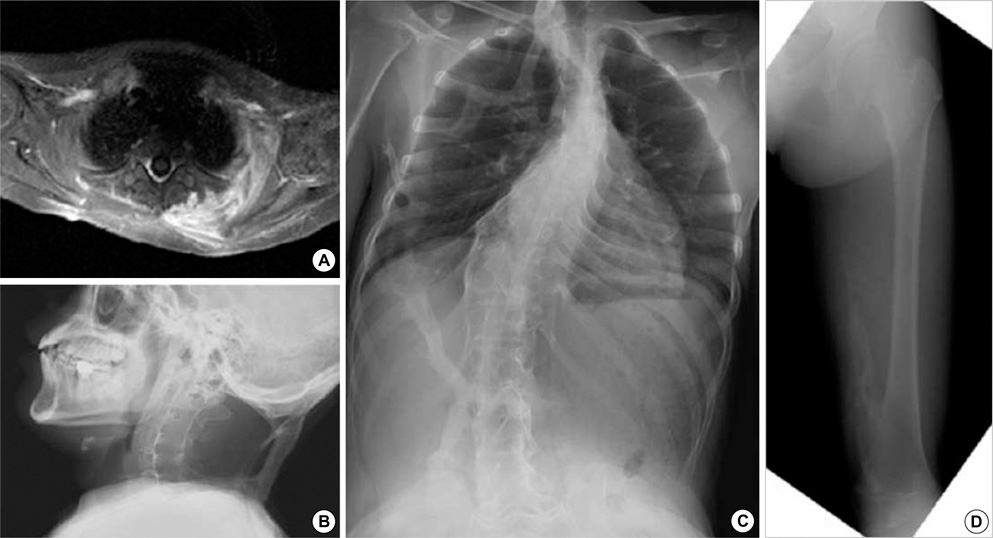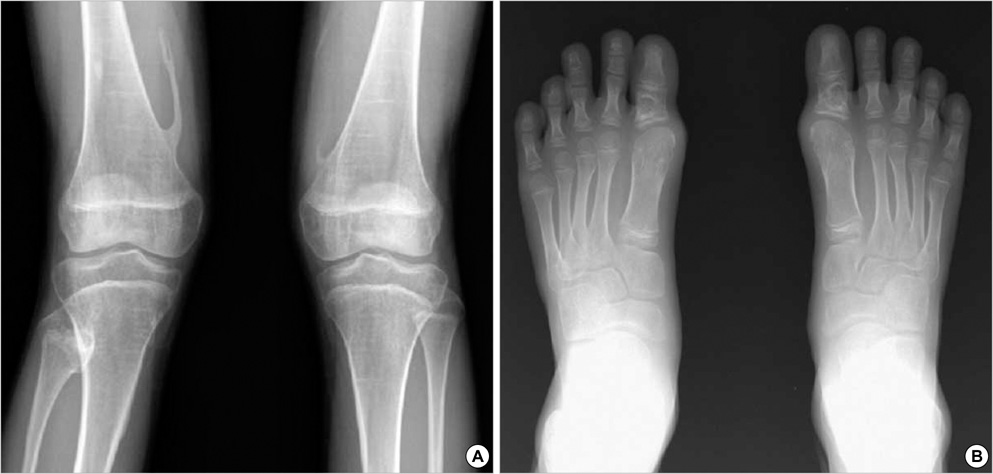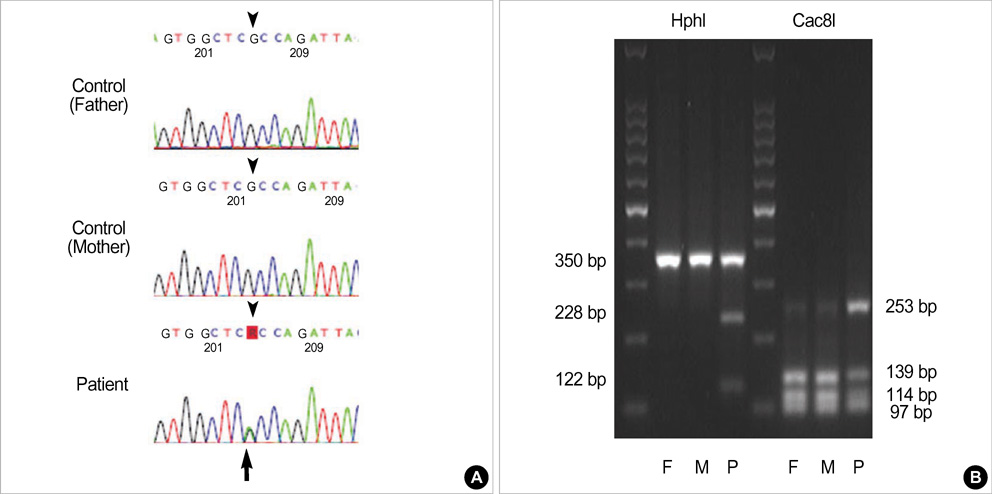J Korean Med Sci.
2009 Jun;24(3):433-437. 10.3346/jkms.2009.24.3.433.
ACVR1 Gene Mutation in Sporadic Korean Patients with Fibrodysplasia Ossificans Progressiva
- Affiliations
-
- 1Department of Orthopaedic Surgery, Seoul National University College of Medicine, Seoul, Korea. tjcho@snu.ac.kr
- KMID: 1779159
- DOI: http://doi.org/10.3346/jkms.2009.24.3.433
Abstract
- Fibrodysplasia ossificans progressiva (FOP; OMIM 135100) is a rare but extremely disabling genetic disorder of the skeletal system, and is characterized by the progressive development of ectopic ossification of skeletal muscles and subsequent joint ankylosis. The c.617G>A; p.R206H point mutation in the activin A type I receptor (ACVR1) gene has been reported to be a causative mutation of FOP. In the present study, mutation analysis of the ACVR1 gene was performed in 12 patients diagnosed or suspected to have FOP. All patients tested had a de novo heterozygous point mutation of c.617G>A; p.R206H in ACVR1. Mutation analysis confirmed a diagnosis of FOP in patients with ambiguous features, and thus, could be used for diagnostic purposes. Early confirmation through mutation analysis would allow medical professionals to advise on the avoidance of provoking events to delay catastrophic flare-ups of ectopic ossifications.
Keyword
MeSH Terms
Figure
Reference
-
1. Groppe JC, Shore EM, Kaplan FS. Functional modeling of the ACVR1 (R206H) mutation in FOP. Clin Orthop Relat Res. 2007. 462:87–92.2. Shore EM, Feldman GJ, Xu M, Kaplan FS. The genetics of fibrodysplasia ossificans progressiva. Clin Rev Bone Miner Metab. 2005. 3:201–204.
Article3. Cohen RB, Hahn GV, Tabas JA, Peeper J, Levitz CL, Sando A, Sando N, Zasloff M, Kaplan FS. The natural history of heterotopic ossification in patients who have fibrodysplasia ossificans progressiva. A study of forty-four patients. J Bone Joint Surg Am. 1993. 75:215–219.
Article4. Kaplan FS, Glaser DL, Shore EM, Deirmengian GK, Gupta R, Delai P, Morhart R, Smith R, Le Merrer M, Rogers JG, Connor JM, Kitterman JA. The phenotype of fibrodysplasia ossificans progressiva. Clin Rev Bone Miner Metab. 2005. 3:183–188.
Article5. Kaplan FS, Tabas JA, Gannon FH, Finkel G, Hahn GV, Zasloff MA. The histopathology of fibrodysplasia ossificans progressiva. An endochondral process. J Bone Joint Surg Am. 1993. 75:220–230.
Article6. Connor JM, Evans DA. Fibrodysplasia ossificans progressiva. The clinical features and natural history of 34 patients. J Bone Joint Surg Br. 1982. 64:76–83.
Article7. Kitterman JA, Kantanie S, Rocke DM, Kaplan FS. Iatrogenic harm caused by diagnostic errors in fibrodysplasia ossificans progressiva. Pediatrics. 2005. 116:e654–e661.
Article8. Shore EM, Xu M, Feldman GJ, Fenstermacher DA, Cho TJ, Choi IH, Connor JM, Delai P, Glaser DL, LeMerrer M, Morhart R, Rogers JG, Smith R, Triffitt JT, Urtizberea JA, Zasloff M, Brown MA, Kaplan FS. A recurrent mutation in the BMP type I receptor ACVR1 causes inherited and sporadic fibrodysplasia ossificans progressiva. Nat Genet. 2006. 38:525–527.9. Nakajima M, Haga N, Takikawa K, Manabe N, Nishimura G, Ikegawa S. The ACVR1 617G>A mutation is also recurrent in three Japanese patients with fibrodysplasia ossificans progressiva. J Hum Genet. 2007. 52:473–475.10. Lin GT, Chang HW, Liu CS, Huang PJ, Wang HC, Cheng YM. De novo 617G-A nucleotide mutation in the ACVR1 gene in a Taiwanese patient with fibrodysplasia ossificans progressiva. J Hum Genet. 2006. 51:1083–1086.11. Choi IH, Chung CY, Cho TJ, Lee DY, Suk SI, Kim WJ, Cho HO, Lee CS, Yoo HW, Yun YH. Fibrodysplasia Ossificans Progressiva. J Korean Orthop Assoc. 1998. 33:1069–1075.
Article12. Janoff HB, Tabas JA, Shore EM, Muenke M, Dalinka MK, Schlesinger S, Zasloff MA, Kaplan FS. Mild expression of fibrodysplasia ossificans progressiva: a report of 3 cases. J Rheumatol. 1995. 22:976–978.13. Kaplan FS, Smith RM. Fibrodysplasia ossificans progressiva (FOP). J Bone Miner Res. 1997. 12:855.
Article14. Crow JF. The origins, patterns and implications of human spontaneous mutation. Nat Rev Genet. 2000. 1:40–47.
Article
- Full Text Links
- Actions
-
Cited
- CITED
-
- Close
- Share
- Similar articles
-
- Head and neck manifestations of fibrodysplasia ossificans progressiva: Clinical and imaging findings in 2 cases
- Recent Topics in Fibrodysplasia Ossificans Progressiva
- Genetic Transmission of Fibrodysplasia Ossificans Progressiva: Report of Two Cases in a Family
- Myositis Ossificans Progressiva: A Case Report
- Myositis ossificans progressiva




